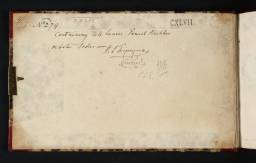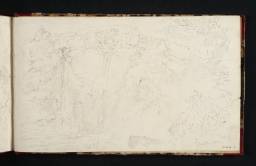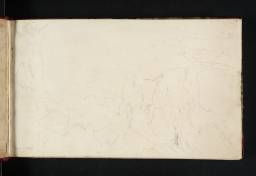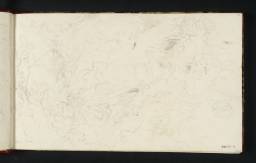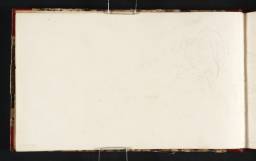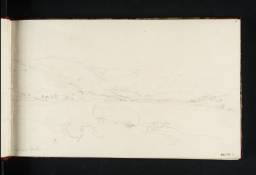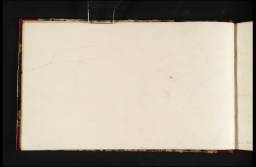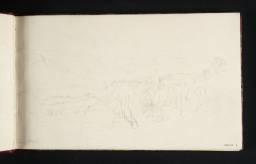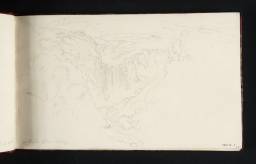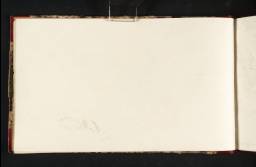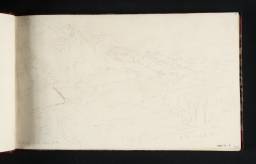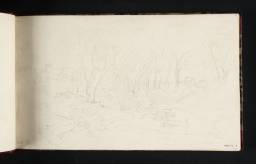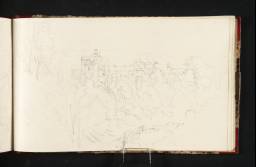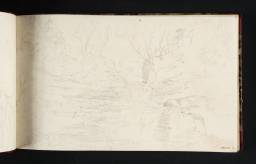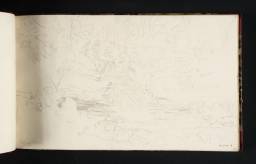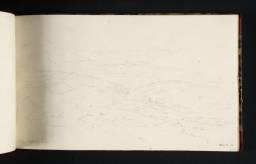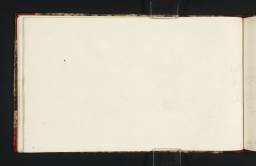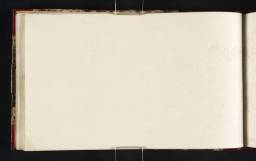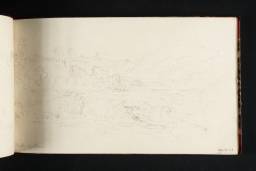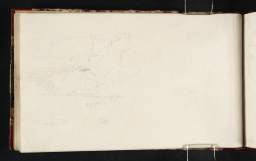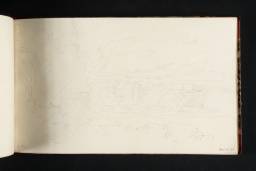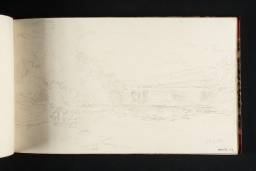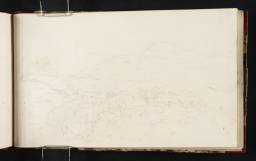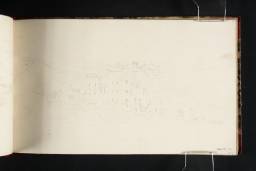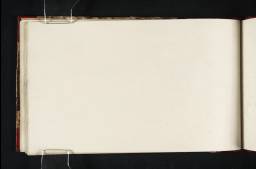Turner Bequest CXLVII
Sketchbook, bound in boards covered in green and black mottled paper with a red leather spine and corners, and a brass catch-plate at the outer edge of the front cover; the corresponding clasp on the back cover now lost
44 leaves of white wove paper made by William (or Catherine) Balston at Springfield Mill, Maidstone, Kent
Approximate page size 125 x 206 mm
Watermarked ‘J WHATMAN | 1814’
Inscribed by Turner in ink ‘Yorkshire 4’ on the spine cloth of the back cover (D40843) and ‘[?41] Yorkshire’ on a small paper label pasted to the spine
Endorsed by the Executors of the Turner Bequest in ink ‘No 279 | Containing 44 Leaves Pencil Sketches | on both sides’, signed by Henry Scott Trimmer ‘H S Trimmer’ and Charles Turner ‘C Turner’ and initialled by Charles Lock Eastlake in pencil ‘C.L.E.’ and John Prescott Knight ‘JPK’ inside front cover (D41497)
Stamped in black ‘CXLVII’ on front and back covers, top right
44 leaves of white wove paper made by William (or Catherine) Balston at Springfield Mill, Maidstone, Kent
Approximate page size 125 x 206 mm
Watermarked ‘J WHATMAN | 1814’
Inscribed by Turner in ink ‘Yorkshire 4’ on the spine cloth of the back cover (D40843) and ‘[?41] Yorkshire’ on a small paper label pasted to the spine
Endorsed by the Executors of the Turner Bequest in ink ‘No 279 | Containing 44 Leaves Pencil Sketches | on both sides’, signed by Henry Scott Trimmer ‘H S Trimmer’ and Charles Turner ‘C Turner’ and initialled by Charles Lock Eastlake in pencil ‘C.L.E.’ and John Prescott Knight ‘JPK’ inside front cover (D41497)
Stamped in black ‘CXLVII’ on front and back covers, top right
Accepted by the nation as part of the Turner Bequest 1856
Exhibition history
References
This medium-sized, landscape-format sketchbook is of the type that Turner often carried with him on major tours and used for more considered drawings after an initial exploration in a smaller notebook. It was used in conjunction with just such a smaller notebook, the Yorkshire 2 sketchbook (Tate D11042–D11371; D40844–D40845; D41443; Turner Bequest CXLV) and with the still larger Yorkshire 5 sketchbook (Tate D11518–D11595; D40860–D40862; Turner Bequest CXLVIII) on a tour of Yorkshire and north Lancashire in the summer of 1816 to collect material for a series of commissioned illustrations for a proposed seven-volume General History of the County of York by Thomas Dunham Whitaker.1 Several of the sketches formed the basis of studio works.
The sketchbook contains some of the most fully developed studies of sites on Turner’s itinerary between 17 July and 11 August 1816. He set out from Farnley Hall, the seat of his Yorkshire patron Walter Fawkes,2 and travelled via Skipton to Browsholme Hall, the Lancashire estate of another patron, Thomas Lister Parker, where he stayed for a week before going to Malham and Gordale whence he struck off alone on horseback, in atrociously wet weather, into the Yorkshire Dales. The sketches in this book begin at Dow Cave near Kettlewell in Upper Wharfedale and continue through Wensleydale and Swaledale to St Agatha’s near Richmond. From there he headed north via Aske Hall and Rokeby where he sketched at Wycliffe and on the River Greta before continuing north into Teesdale. After Upper Teesdale Turner seems to have put the book away for a little while before the sketches pick up again in the Kendal area, and continue around the northern shore of Morecambe Bay. The sketchbook finishes at Heysham, in the Lune Valley, at the caves around Ingleton, and at Kendal and Skipton as he returned to Farnley Hall.
While the sketchbook itself contains no documentary evidence for dating, it may be securely dated to 1816 by association with the Yorkshire 2 and Yorkshire 5 sketchbooks. It is known from the diaries of Maria Sophia, the wife of Walter Fawkes, extracts from which were first published by Alexander Finberg in 1912,3 that the Fawkes party, accompanied by Turner, left Farnley on 17 July and travelled via Skipton to Browsholme Hall in Lancashire. They stayed until 24 July when they left for Malham, and on the next day visited nearby Gordale Scar, before parting from Turner who went off ‘on a sketching tour’. The Yorkshire 2 sketchbook follows every aspect of that itinerary and charts the whole of the subsequent tour. The first sketches in the present book were made in Wharfedale, just after Turner had parted from the Fawkes family at Malham, but the itinerary documented by the sketches closely mirrors those of the Yorkshire 2 and Yorkshire 5 sketchbooks. A letter written by Turner from Richmond in Yorkshire on 31 July 18164 dates the sketches in that area, and from internal indications such as times of day indicated by shadows, the present writer has proposed a day-by day dating of the sketches up to Turner’s return to Farnley in time for the opening of the shooting season on 12 August.
For Fawkes generally see James Hamilton, ‘Fawkes, Walter Ramsden (1769–1825)’, in Evelyn Joll, Martin Butlin and Luke Herrmann (eds.), The Oxford Companion to J.M.W. Turner , Oxford 2001, pp.103–5.
Technical notes
How to cite
David Hill, ‘Yorkshire 4 sketchbook 1816’, sketchbook, February 2009, in David Blayney Brown (ed.), J.M.W. Turner: Sketchbooks, Drawings and Watercolours, Tate Research Publication, December 2013, https://www

